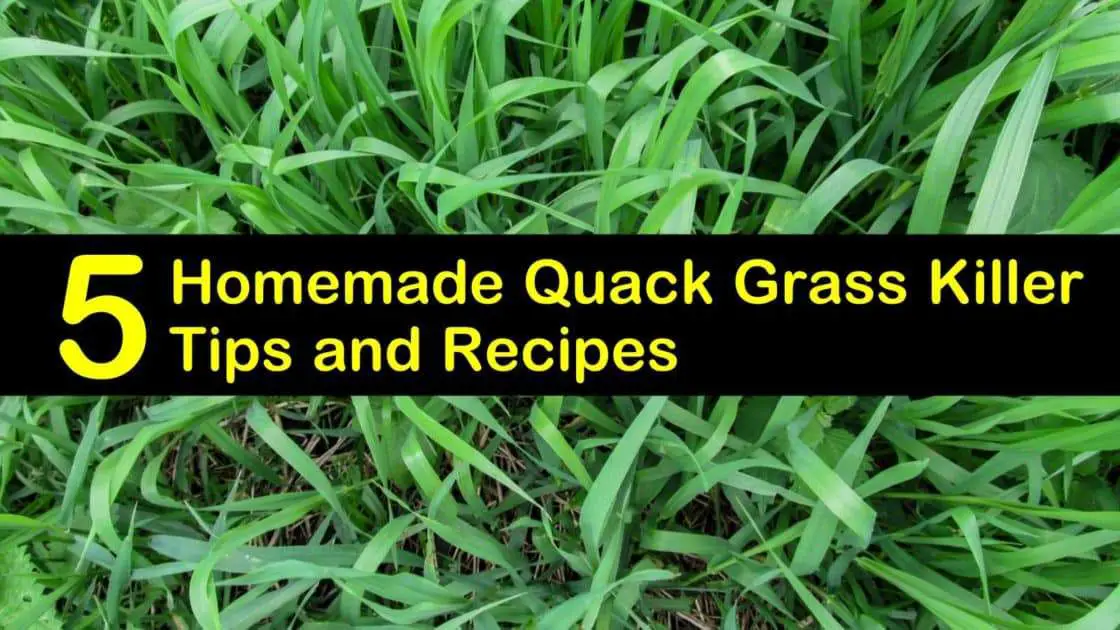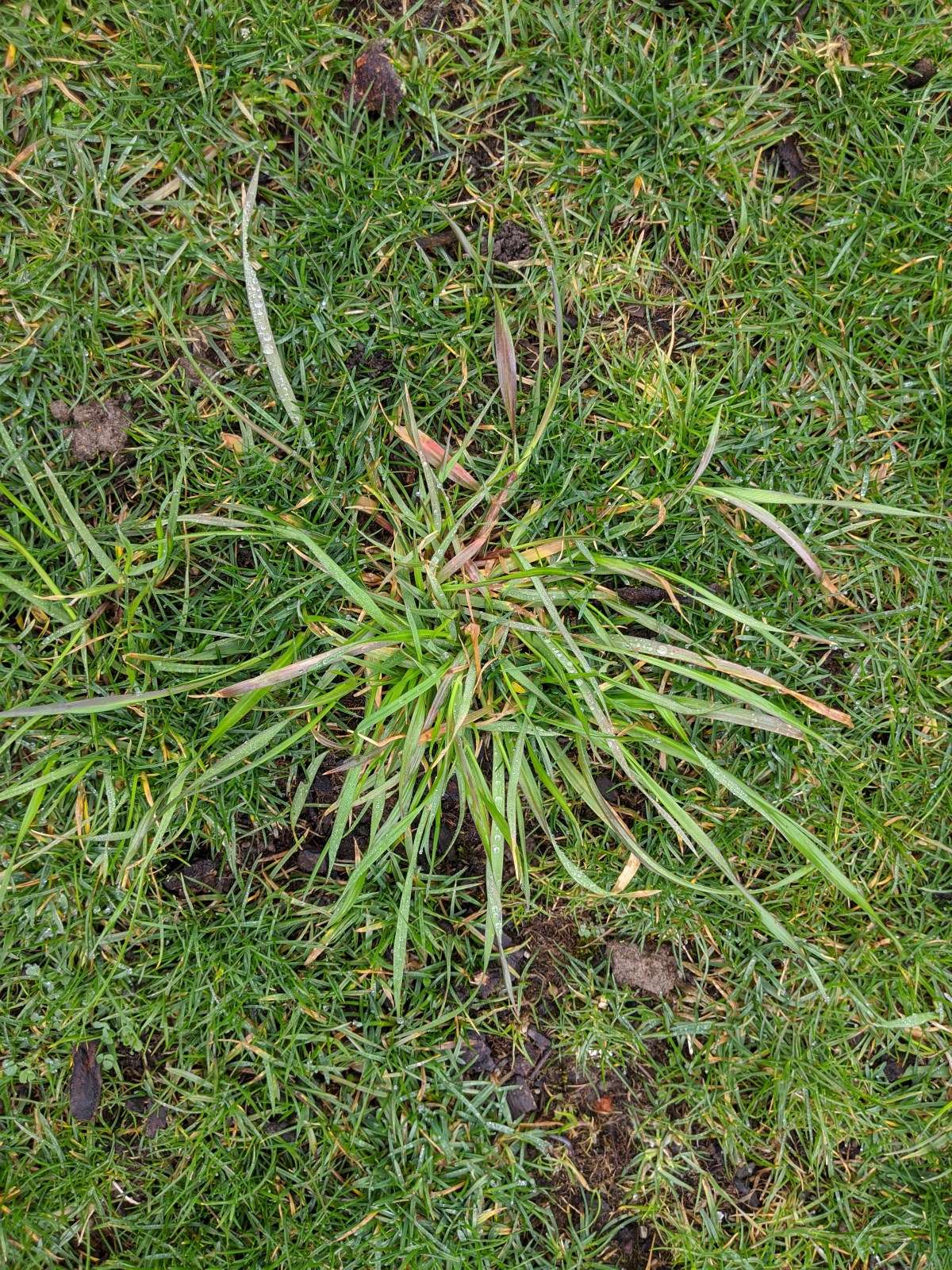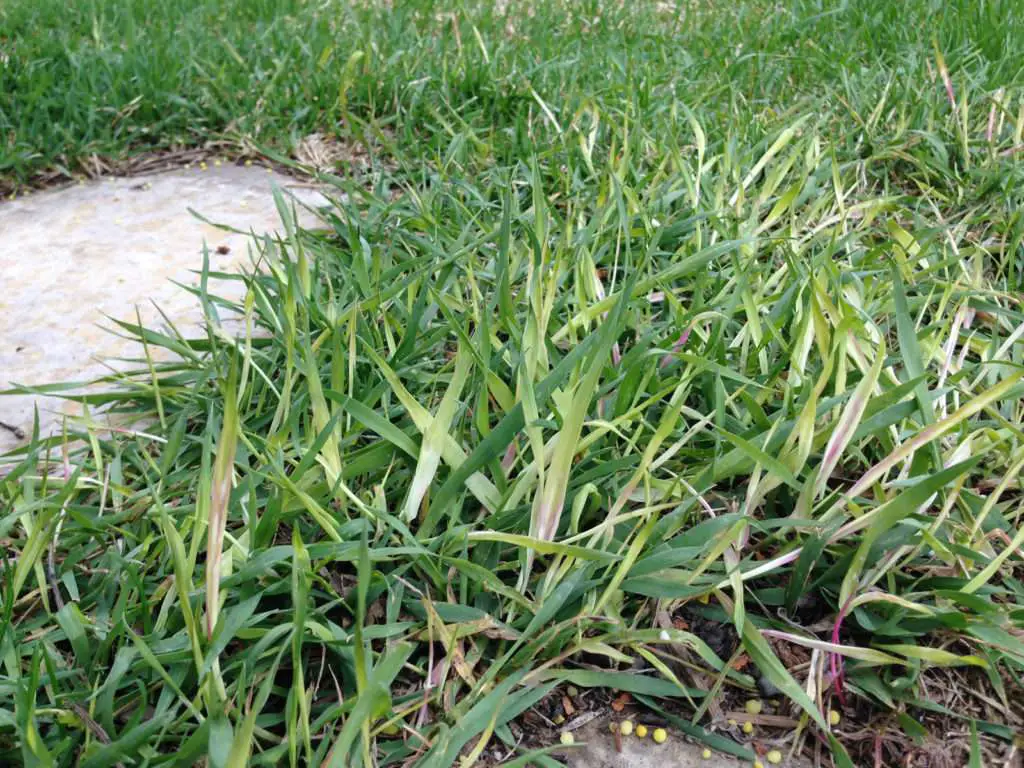When To Rake Mulch Off Of Asparagus Plants
Rake mulch that has fallen from the garden in early spring before the first asparagus shoots touch the ground. Remove small weeds growing under the mulch and continue weeding as needed while the asparagus tips develop. When the stems are long enough to begin harvesting, replace the mulch to suppress weed growth.
Manually Remove The Quackgrass
Brandon warns that one of your only options to get rid of quackgrass is to pull it out by hand. When manually removing the weed, you should try to pull as much of the root out of the soil as possible to destroy the deep-rooted systems.
However, while pulling out your quackgrass is an option, Professor Richard VanVranken warns that this process comes with its challenges.
‘If the quackgrass is in a very small area of turf, or especially in a tilled vegetable garden, one could dig out a few small clumps, carefully avoiding breaking any of the underground stems as much as possible,’ Richard says. He adds that you should remove any new sprouts if any broken-off rhizomes do regenerate.
‘It’s to distinguish new young quackgrass sprouts amid the turf grasses, so that’s not going to be easy,’ the professor warns. ‘Depending on the size of the vegetable garden, and the severity of the infestation, hand removal may be overwhelming in your situation.’
How To Get Rid Of Quackgrass Using Vinegar
The correct ratio for killing weeds with vinegar is 1 gallon of 10%-20% vinegar to one cup of orange oil. If you have more weeds to take care of, use a type of sprayer that will cover a wide area. Here are my recommended products:
Affiliate links and images pulled from the Amazon Product Advertising API on: 2021-07-19
Heres how to kill quackgrass using vinegar.
This combination works best when applied at full strength in sunlight as the day gets heated up. To maintain its potency, you should not apply vinegar weed killer less than 24 hours after rains or when the forecast indicates an impending rain within the next 24 hours.
This means that if the rains fell yesterday, you wont be doing much if you apply the weed killer today. The optimum working conditions and maximum efficacy for vinegar weed killer averages at 70 degrees Fahrenheit.
Read Also: Rent Sander Lowes
What Is Quackgrass In Lawn
Quackgrass is a type of invasive, cool-season perennial weed thats extremely difficult to get rid of. It goes by a lot of names, including:
- Witchgrass
- Scutch grass
- Twitch
Quackgrass is native to Africa, Asia, Europe, and the arctic tundra. It was introduced in North America in the mid-1600s, mainly for erosion control.
Of course, people quickly realized how difficult it was to remove it from gardens and lawns.
Painting Roundup On Quack Grass

The roundup is the best non-selective herbicide to fight against the quack grass. However, note that these chemicals will also kill any plants it comes across. Although extreme, this method is the single most effective way to get rid of weeds.
To get maximum results, you need to use it in fall or spring, before planting. Do it at least twice, with an application interval of 14 days. You can start planting seven days after the second application.
However, the results will also depend on several factors, including the stage of plant growth, plant strength, air temperature, and several factors that affect fertility. The painting roundup on quack grass is best around 16 degrees C. Hotter weather will reduce the effectiveness of the herbicide.
You May Like: Aerify Plus Lowes
How Do You Prevent Quackgrass
To prevent infestations from spreading, spot treat with an effective herbicide to control isolated patches of quackgrass in fields, along fencerows and roadsides, and in noncrop areas. Clean and remove rhizome fragments from plows, disks, and harrows to avoid introducing fragments or seeds into other areas.
Donât Miss: Tru Maintenance Lawn Plan
Chemical Control In Perennial Beds
When controlling quack grass with herbicides in perennial beds, itâs hard to avoid spraying desirable plants, but selective herbicides provide a solution. Some herbicides target grasses, and these are safe to use around most perennial plants except ornamental grasses and plants with grasslike or swordlike stems. To be completely safe, itâs best to cover all the plants you wish to keep with paper bag loosely tied at the base when spraying herbicides on a perennial bed. Put on protective clothing, and spray quack grass plants with a ready-to-use 0.48 percent fluazifop-p-butyl herbicide, on a dry, still day when the quack grass is actively growing. Paint the herbicide on quack grass leaves and stems if itâs difficult to avoid spraying desired plants. Remove the bags from plants when the herbicide is dry, and spray the quack grass again if it reappears.
Also Check: Lawn Love Requirements
Does Vinegar Kill Quackgrass Weed
Vinegar can get rid of crabgrass. A strong solution of vinegar, when mixed with orange oil, can kill weeds for good. However, this process has to be done in the correct manner lest the weeds sprout forth again.
Most vinegar solutions are not effective in killing weeds because they are not appropriately prepared. While most blogs will give tutorials on how to make a vinegar weed killer, most of the content is laced with faulty information that does not yield any desirable result.
This is because most of these tutorials only show vinegar with an acidity of 5% which does not help significantly.
Household vinegar rarely kills weeds, though it may cause some of the weeds to shrivel and wilt a bit but not to die off completely. Noxious, hardcore weeds will need stronger agents for their complete eradication.
To ensure that you achieve better results with your vinegar solution, you need to get vinegar with an acidity of at least 10%.
You should, however, be careful when handling vinegar with more than 10 percent acidity because it is very potent and dangerously corrosive. It can burn your skin and cause very painful wounds.
To keep yourself safe, wear goggles, long sleeves, rubber gloves, and shoes when you are working with 10% to 20-% vinegar solutions. It is also important to apply vinegar mixed with orange oil.
While vinegar can solely destroy weeds without a problem, it is the orange oil component that greatly completes the entire process of weed control.
Selective Herbicide Quackgrass Killer
Selective herbicides work systemically to kill the quackgrass from the inside out. Look for herbicides containing fluazifop. Wait until the weather forecast calls for no rain for at least 48 hours and carefully apply the herbicide to the leaves of the quackgrass. Apply the herbicide when the quackgrass is very young, with only two to four leaves. A second application may be necessary. Follow label directions.
You May Like: Lowes Lawn Roller Rental
Option : Mechanical Removal
Due to the perennial nature of quackgrass and its well-developed rhizome system, it is very difficult to remove by mechanical means. Methods include digging up the offending patches, including several inches of soil and replacing with new topsoil and reseeding. However, the rhizomes of quackgrass can grow 6 to 8 feet deep in the ground, and these rhizomes could potentially “push” new plants to the surface.
Another option is solarization. This method uses clear plastic fastened securely to the ground over the quackgrass areas. Be sure to cut the plastic slightly larger than the patches. Leave the plastic in place for five to seven days in the spring or summer when the weather is nice. The plastic will help trap the heat close to the soil surface and hopefully devitalize the plant material. After removing the plastic, you may reseed the area.
Choking Out Quack Grass
Quack grass does have tremendous competitive power in terms of nutrient absorption. However, for your information, this will only happen if the competing grass is not active enough, but if you can raise the vigor of the lawn to fight back, then this problem can be solved.
The only way is to increase soil fertility. Try using a nitrogen fertilizer of 0.25 to 0.5 pounds per 1000 feet of soil. Do this twice a week during the growing season. When summer comes, stop this process first.
Afterward, try to observe the progress in the following season. If this program carried out properly, the weeds have a smaller structure than before. Try to do this process again in the next growing season until the unwanted plants are gone.
Also Check: Lowes Lapping Compound
Also Check: Home Depot Coupons On Lawn Mowers
Easy Solutions For Getting Rid Of Quackgrass
Have you ever noticed grass that springs up where it doesnt belong? You may have unwanted quackgrass! What is quackgrass, and how do you get rid of it? Can it be prevented? These are questions that many homeowners have during this time of year.
So, how do you get rid of quackgrass? The easiest way to get rid of quackgrass in your yard is to use a herbicide specifically formulated for this purpose. Additionally, you can use a high-quality fertilizer to encourage the growth of healthy grass. This will eventually overtake the unwanted quackgrass.
Weve written this article to help you identify and get rid of quackgrass. Keep reading to learn more about a few easy solutions for your convenience.
How To Get Rid Of Quackgrass According To Experts

‘Quackgrass is an invasive weed that is extremely difficult to get rid of after it has taken root in your yard or garden, so the best thing you can do is to prevent it from growing in the first place,’ says Brandon Ballweg, a garden expert from Solid Ground Environmental.
However, while we admit that prevention is better than the cure, it is possible to regain control over your garden with the right advice. This is how to get rid of quackgrass, the professional way.
Read Also: Is Trugreen Lawn Care Safe For Pets
How Do I Get Rid Of Nutsedge
Nutsedge control It can only be controlled by a post-emergent herbicide. The key to controlling nutsedge is to kill off the nutlet with a herbicide product, most control products take about 10-14 days to completely kill off the plant. It is difficult to get rid of nutsedge and it may require multiple treatments.
You May Like: Recover Lawn Chairs
Is It Safe To Apply Vinegar On Your Lawn
The major downside of this brew of vinegar and orange oil is that it is not discriminative. It kills anything in its path. Therefore, you should be really careful when applying it to your lawn lest the entire lawn dries up.
It kills plants, flowers, and grass just as effectively as it kills weeds. The best strategy to keep your flowers, plants, and grasses safe is by avoiding the use of vinegar weed killer on windy days. You can also use a paintbrush as an alternative for spray can to selectively eliminate quackgrass amidst other grasses in the lawn.
You May Like: Violet Killer For Lawns
How To Eradicate Quackgrass In Lawn For Good
At first glance, a few clumps of thick grass here and there may not seem like a big deal. Right?
Unfortunately, these patches of quick-sprouting grass may soon grow to become one of the most formidable enemies to your home lawn.
If you notice a bunch of grassy weeds spreading across your lawn, you might be dealing with a type of invasive weed called quack grass.
Quack grass in lawn is definitely not easy to deal with, but this is where we step in.
In this article, well extensively cover how to identify quack grass, eliminate it from your lawn, and prevent it from making a sneaky comeback.
Lets get started!
Carefully Dig Up The Quackgrass
Your initial instinct when you run across Quackgrass growing on your lawn is to reach for it and yank it up. That can sometimes take care of your issue when the plant is young, but its easy to spread seeds around and leave yourself with a bigger mess than you already had.
Because Quackgrass tends to disintegrate and spread when you dig it up, its essential to take care when doing so. Never use a rototiller on Quackgrass youll break up the Quackgrass rhizomes and spread the seed all over the yard.
- Grass seeds
Use a shovel or another digging tool to dig a circle a foot in diameter around the weed and dig down about a foot into the soil to make sure you get the entire root ball.
Even a scrap of the plant can result in new growth, so take your time and make sure you get every bit of the underground stems. Throw the weeds into a trash bag and seal it. Seed the area with new grass to prevent the weed from returning.
Use hand pulling as the best way to kill poison ivy, too. However, be sure to wear protective clothing and gloves to prevent the spread of urushiol on your skin and increase the potential for an allergic reaction.
Read Also: Expert Gardener Crabgrass Preventer Plus Fertilizer
How To Get Rid Of Quack Grass From Lawn
The existence of quack grass may not be new to the gardeners. This plant often appears in the middle of green grass in the yard. Unfortunately, it is not something you want because it can cause effects for others.
However, you do not need to worry about its existence. You can control a natural plant in the right way, but to handle it well, you need to know everything about it. You can even actually take advantage of this plant.
Contents
Read Also: Cost For Trugreen
Controlling And Getting Rid Of Quackgrass Takes Persistence But It Can Be Done Here’s How To Kill The Invasive Perennial Before It Takes Over Your Lawn
Despite its whimsical name, quackgrass is a formidable enemy that can take over a lawn quickly. Its strong, deep root system can grow into separate plant clumps if split, and no selective herbicide will kill it while leaving your lawn unaffected. Thats why quackgrass also known as couch grass, twitch, quick grass, quitch grass, dog grass, scutch grass and witchgrass is considered one of the hardest weeds to eradicate.
Quackgrass is a large nuisance in home lawns because it is tough to get rid of, says Drew Wagner of Sod Solutions. Removing this grass requires persistence and frequent inspection.
If you spot clumps of quick-sprouting grass that is taller than your turf, with broad rough leaves and thick white roots, you may have a quackgrass invasion. Read on to learn how to identify this aggressive invader and eradicate it for good.
Don’t Miss: Aarons Lawnmowers
Controlling And Getting Rid Of Quackgrass Takes Persistence But It Can Be Done Heres How To Kill The Invasive Perennial Before It Takes Over Your Lawn
Despite its whimsical name, quackgrass is a formidable enemy that can take over a lawn quickly. Its strong, deep root system can grow into separate plant clumps if split, and no selective herbicide will kill it while leaving your lawn unaffected. Thats why quackgrass also known as couch grass, twitch, quick grass, quitch grass, dog grass, scutch grass and witchgrass is considered one of the hardest weeds to eradicate.
Quackgrass is a large nuisance in home lawns because it is tough to get rid of, says Drew Wagner of Sod Solutions. Removing this grass requires persistence and frequent inspection.
If you spot clumps of quick-sprouting grass that is taller than your turf, with broad rough leaves and thick white roots, you may have a quackgrass invasion. Read on to learn how to identify this aggressive invader and eradicate it for good.
How To Identify Quackgrass In Lawn

At first glance, you might not be able to identify quackgrass. They look remarkably similar to other grass weeds like ryegrass, crabgrass, and tall fescue.
To identify quackgrass in your lawn, you need to look for two characteristic features.
The first thing is the clasped auricles that enclose the seed head, rhizomes, and stem.
Youll find that a lot of grass weeds have similar auricles, but only quackgrass has these characteristic rhizomes widespread deep in the soil.
Each rhizome has the potential to bring out a new plant, which makes it incredibly invasive. These roots are three to six inches deep and have pin-sharp tips. New rhizomes have a yellowish-white color with a glossy look, while older rhizomes are brown.
The sharp tips on the rhizomes enable them to penetrate through virtually anything. This is why quackgrass can start growing through concrete.
Recommended Reading: Best Rear Engine Riding Mower 2017
What Is Quack Grass
Quack grass is a perennial weed because it can survive any season. She thrives on rhizomes that can store food reserves. Its roots stretch up to 6 feet below the ground, allowing it to stay alive after being uprooted.
As explained above, it is detrimental because it will invade food in the soil. The ability to absorb nutrients will make it difficult for your plants to compete so that it is hard to grow well. On the other hand, this weed is also difficult to kill because of its resistant roots.
Invasive Grasses In Lawns Prevention
While quackgrass seed may be dispersed by the wind and rhizomes may hide underground, there are some steps you can take to avoid inadvertently introducing quackgrass to your garden. Its best to buy only high-quality garden seeds from reputable sources.
Avoid using straw mulch or livestock feed that may be infested with quackgrass. Keep the area around the garden mowed and make sure clippings that may contain quackgrass seeds blow away from the garden. Do not use grass clippings for mulch if there is quackgrass in the lawn.
References
Read Also: What Is Preemergent
